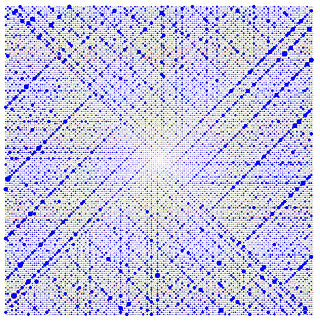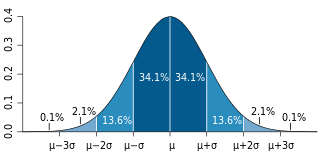Related Research Articles
Calculus is the mathematical study of continuous change, in the same way that geometry is the study of shape, and algebra is the study of generalizations of arithmetic operations.

John von Neumann was a Hungarian and American mathematician, physicist, computer scientist and engineer. He had perhaps the widest coverage of any mathematician of his time, integrating pure and applied sciences and making major contributions to many fields, including mathematics, physics, economics, computing, and statistics. He was a pioneer in building the mathematical framework of quantum physics, in the development of functional analysis, and in game theory, introducing or codifying concepts including cellular automata, the universal constructor and the digital computer. His analysis of the structure of self-replication preceded the discovery of the structure of DNA.

Number theory is a branch of pure mathematics devoted primarily to the study of the integers and arithmetic functions. German mathematician Carl Friedrich Gauss (1777–1855) said, "Mathematics is the queen of the sciences—and number theory is the queen of mathematics." Number theorists study prime numbers as well as the properties of mathematical objects constructed from integers, or defined as generalizations of the integers.

A number is a mathematical object used to count, measure, and label. The most basic examples are the natural numbers 1, 2, 3, 4, and so forth. Numbers can be represented in language with number words. More universally, individual numbers can be represented by symbols, called numerals; for example, "5" is a numeral that represents the number five. As only a relatively small number of symbols can be memorized, basic numerals are commonly organized in a numeral system, which is an organized way to represent any number. The most common numeral system is the Hindu–Arabic numeral system, which allows for the representation of any non-negative integer using a combination of ten fundamental numeric symbols, called digits. In addition to their use in counting and measuring, numerals are often used for labels, for ordering, and for codes. In common usage, a numeral is not clearly distinguished from the number that it represents.

A prime number is a natural number greater than 1 that is not a product of two smaller natural numbers. A natural number greater than 1 that is not prime is called a composite number. For example, 5 is prime because the only ways of writing it as a product, 1 × 5 or 5 × 1, involve 5 itself. However, 4 is composite because it is a product (2 × 2) in which both numbers are smaller than 4. Primes are central in number theory because of the fundamental theorem of arithmetic: every natural number greater than 1 is either a prime itself or can be factorized as a product of primes that is unique up to their order.
In physics, string theory is a theoretical framework in which the point-like particles of particle physics are replaced by one-dimensional objects called strings. String theory describes how these strings propagate through space and interact with each other. On distance scales larger than the string scale, a string looks just like an ordinary particle, with its mass, charge, and other properties determined by the vibrational state of the string. In string theory, one of the many vibrational states of the string corresponds to the graviton, a quantum mechanical particle that carries the gravitational force. Thus, string theory is a theory of quantum gravity.

In probability theory and related fields, a stochastic or random process is a mathematical object usually defined as a family of random variables in a probability space, where the index of the family often has the interpretation of time. Stochastic processes are widely used as mathematical models of systems and phenomena that appear to vary in a random manner. Examples include the growth of a bacterial population, an electrical current fluctuating due to thermal noise, or the movement of a gas molecule. Stochastic processes have applications in many disciplines such as biology, chemistry, ecology, neuroscience, physics, image processing, signal processing, control theory, information theory, computer science, and telecommunications. Furthermore, seemingly random changes in financial markets have motivated the extensive use of stochastic processes in finance.

The Large Scale Structure of Space–Time is a 1973 treatise on the theoretical physics of spacetime by the physicist Stephen Hawking and the mathematician George Ellis. It is intended for specialists in general relativity rather than newcomers.

Hilbert's problems are 23 problems in mathematics published by German mathematician David Hilbert in 1900. They were all unsolved at the time, and several proved to be very influential for 20th-century mathematics. Hilbert presented ten of the problems at the Paris conference of the International Congress of Mathematicians, speaking on August 8 at the Sorbonne. The complete list of 23 problems was published later, in English translation in 1902 by Mary Frances Winston Newson in the Bulletin of the American Mathematical Society. Earlier publications appeared in Archiv der Mathematik und Physik.

John Carlos Baez is an American mathematical physicist and a professor of mathematics at the University of California, Riverside (UCR) in Riverside, California. He has worked on spin foams in loop quantum gravity, applications of higher categories to physics, and applied category theory. Additionally, Baez is known on the World Wide Web as the author of the crackpot index.
Frank Jennings Tipler is an American mathematical physicist and cosmologist, holding a joint appointment in the Departments of Mathematics and Physics at Tulane University. Tipler has written books and papers on the Omega Point based on Pierre Teilhard de Chardin's religious ideas, which he claims is a mechanism for the resurrection of the dead. He is also known for his theories on the Tipler cylinder time machine. His work has attracted criticism, most notably from Quaker and systems theorist George Ellis, who has argued that his theories are largely pseudoscience.

The Bogdanov affair was an academic dispute over the legitimacy of the doctoral degrees obtained by French twins Igor and Grichka Bogdanov and a series of theoretical physics papers written by them in order to obtain degrees. The papers were published in reputable scientific journals, and were alleged by their authors to culminate in a theory for describing what occurred before and at the Big Bang.

The sociology of scientific knowledge (SSK) is the study of science as a social activity, especially dealing with "the social conditions and effects of science, and with the social structures and processes of scientific activity." The sociology of scientific ignorance (SSI) is complementary to the sociology of scientific knowledge. For comparison, the sociology of knowledge studies the impact of human knowledge and the prevailing ideas on societies and relations between knowledge and the social context within which it arises.

Mathematics emerged independently in China by the 11th century BCE. The Chinese independently developed a real number system that includes significantly large and negative numbers, more than one numeral system, algebra, geometry, number theory and trigonometry.

Irving Ezra Segal (1918–1998) was an American mathematician known for work on theoretical quantum mechanics. He shares credit for what is often referred to as the Segal–Shale–Weil representation. Early in his career Segal became known for his developments in quantum field theory and in functional and harmonic analysis, in particular his innovation of the algebraic axioms known as C*-algebra.
The International Colloquium on Group Theoretical Methods in Physics (ICGTMP) is an academic conference devoted to applications of group theory to physics. It was founded in 1972 by Henri Bacry and Aloysio Janner. It hosts a colloquium every two years. The ICGTMP is led by a Standing Committee, which helps select winners for the three major awards presented at the conference: the Wigner Medal (1978–2018), the Hermann Weyl Prize and the Weyl–Wigner Award.

The infinite series whose terms are the natural numbers 1 + 2 + 3 + 4 + ⋯ is a divergent series. The nth partial sum of the series is the triangular number
A Usenet personality was a particular kind of Internet celebrity, being an individual who gained a certain level of notoriety from posting on Usenet, a global network of computer users with a vast array of topics for discussion. The platform is usually anonymous, although users can get celebrity status, usually by being deemed different from other posters in some way.
This is a timeline of pure and applied mathematics history. It is divided here into three stages, corresponding to stages in the development of mathematical notation: a "rhetorical" stage in which calculations are described purely by words, a "syncopated" stage in which quantities and common algebraic operations are beginning to be represented by symbolic abbreviations, and finally a "symbolic" stage, in which comprehensive notational systems for formulas are the norm.
In mathematics, the cobordism hypothesis, due to John C. Baez and James Dolan, concerns the classification of extended topological quantum field theories (TQFTs). In 2008, Jacob Lurie outlined a proof of the cobordism hypothesis, though the details of his approach have yet to appear in the literature as of 2022. In 2021, Daniel Grady and Dmitri Pavlov claimed a complete proof of the cobordism hypothesis, as well as a generalization to bordisms with arbitrary geometric structures.
References
- ↑ Hubbard, Douglas W. (2009-04-27). The Failure of Risk Management: Why It's Broken and How to Fix It. John Wiley & Sons. ISBN 9780470387955.
- ↑ Wired Staff. "Every field of study deserves its own Crackpot Index". WIRED. Archived from the original on July 17, 2018. Retrieved 2018-07-17.
- ↑ "Towards a universal crackpot standard". New Scientist . 28 April 2010. Retrieved 2023-08-10.
- ↑ "Crackpot index". math.ucr.edu. Retrieved 2018-07-17.
- 1 2 "Crackpot index". 1996-11-10. Archived from the original on 1996-11-10. Retrieved 2018-07-17.
- ↑ "Feedback". New Scientist . 5 December 1992. Retrieved 2023-08-10.
- ↑ Kesterton, Michael (11 Dec 1992). "Social Studies a Daily Miscellany of Information by Micheal Kesterton About the Body …". The Globe and Mail . Toronto. p. A.28.
- ↑ Baez, John (23 January 1993). "Letters: Crackpot credit". New Scientist . No. 1857. Retrieved 2023-08-10.
- ↑ Baez, John (2001). "The crackpot index". Skeptic . Vol. 8, no. 4. Altadena, CA. Contents
- ↑ Chris Caldwell. "The PrimeNumbers' Crackpot index" . Retrieved October 23, 2007.
- ↑ Fred J. Gruenberger. "A Measure for Crackpots" (PDF).